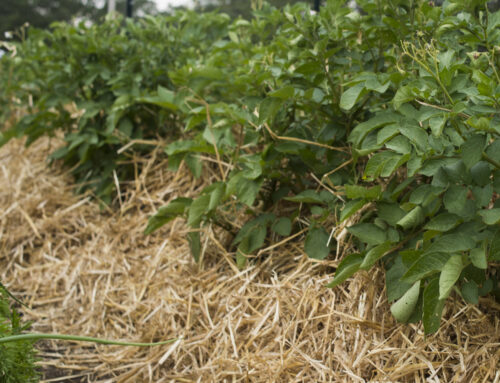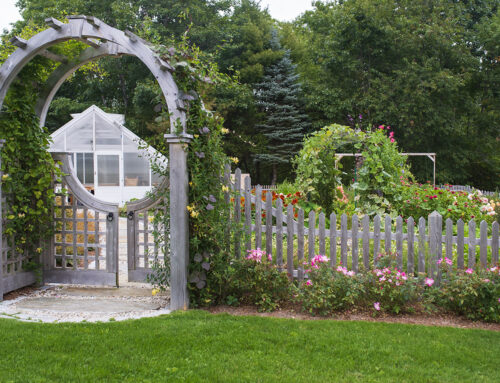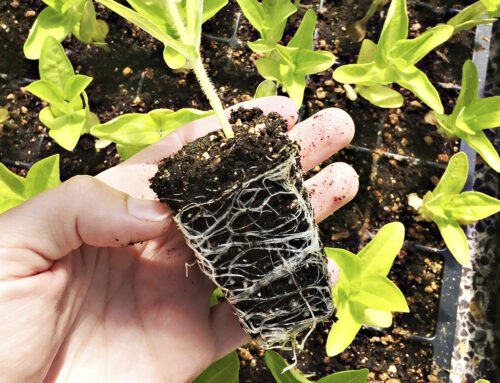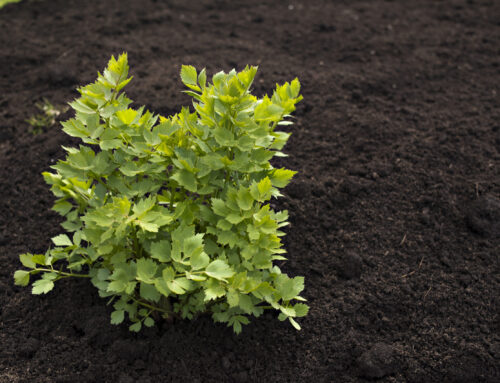No Dig Gardening has changed my life. This is not hyperbole, just truth. Six years ago I stumbled across a vegetable book by new-to-me Charles Dowding, TheVeg Journal: Expert no-dig advice, month by month (not sponsored or affiliate, I just love his books), and it literally changed the way I garden.

Donate your rototiller, because there’s no more tilling. No digging either. When soil microorganisms are left undisturbed—they thrive, which means your soil, and therefore your entire garden will also thrive. Let me share with you all the reasons why you should incorporate this practice into your garden.
No-Dig Gardening Benefits:
- Save time, money and your back! No tiller, no backbreaking digging, less water and healthier plants.
- Requires less annual compost than traditionally dug garden beds.
- Increased moisture retention.
- Fewer weeds.
- Fungi—particularly mycorrhizae (more on that in my next post), bacteria and other helpful microorganisms that live and work in your soil, stay intact.
- Higher level of earthworms, AKA Mother Nature’s soil cultivators.
- Improved soil structure and drainage (thanks to those helpful microbes and earthworms).
- Healthier, bigger, more abundant vegetable, flower and herb harvests!
How No-Dig is Different:
Traditional gardening involves turning your soil annually, which means digging. Each time you till your soil, you kill soil life and breaking down the structure that has established itself over the growing season.
One of the hardest working creatures in the garden is the earthworm. Earthworms do two things. They process the organic material found in soil and compost, turning it into available nutrients, and improve soil structure by tunneling through the soil. These channels leave room for air, water, and plant roots. Additionally earthworms spread and distribute the nutrients throughout the soil as they tunnel about, think of them as Mother Nature’s tiller. So when you till, you not only destroy the earthworms, you are damaging your soil structure.
No-Dig gardening protects the earthworms, protects the soil structure, as well as all the other beneficial fungi, bacteria and microbes that keep your soil working and healthy.

And don’t even get me started on what digging and tilling does to the mycorrhizal fungi. I’m going to do a deep dive into Mycorrhizae in my next post, but just know that they are incredibly important to plant health and production. You want this fungi in your soil. You do not want to destroy it.
Implementing no-dig into your garden practice is so easy. Stop turning and tilling your soil! Then, add compost. That’s really all there is to it.
Compost is a Key Piece of No-Dig
If I had to give only one piece of advice about gardening, it would be to get your soil straight. Spend your money good soil, particularly compost.
Compost is balanced, healthy food that’s good for all plants, regardless of whether they are nitrogen-hungry or not. It won’t “fork” your carrots or create overly leafy tomato plants. Those problems are from junk-food fertilizers applied incorrectly. Compost is another story all together. Feel free to generously apply it in abundance to all your beds as needed throughout the growing season.
My Favorite Compost: Surf n’ Turf
Filled with all the organic stuff found on the ground, as well as marine life, Surf n’ Turf is simply amazing. I could not believe the difference in my garden when I changed from traditional, agricultural compost to this stuff. It is truly black gold. Mainers and other New Englanders, I get mine from Benson’s Farm, and it’s worth every freakin’ penny!

What makes Surf n’ Turf so amazing is: food scraps, farm animal bedding and seafood waste. The first two are known components of the classic compost we all make in our backyards. Seafood waste is what makes this compost a star. Marine life is full of many micronutrients and hormones that are valuable to growing plants. Additionally the crustacean shells contain a potent protein with antimicrobial properties called chitin. Recently, these antimicrobial properties have been pests and disease reduction. So really, why isn’t Surf n’ Turf everybody’s favorite compost?
Now that we’ve reached an understanding on the importance of compost, let’s talk about how to convert your garden into a no-dig extravaganza.
How to transform your garden with no-dig beds
Whether beginning with an existing garden bed or creating a new one, the no-dig method can be applied immediately. For already established beds, do nothing more than level your soil with a rake, then spread 3-5” of compost. Boom! That’s it!

There’s slightly more involved when starting garden beds from scratch. First remove any large rocks and major perennial weeds. Baring any significant weed difficulties (think bindweed), you can simply add a layer of thick cardboard on top of grass and weeds where you want the new bed located, and top it with 6” of compost.
If you prefer raised beds, build the beds and again, layer with thick cardboard and fill with compost. For deep raised beds I fill the lower portion with a 50/50 loam and compost mix, with the six topmost inches finished off exclusively with compost. The crazy thing is you can actually plant into this new growing space, immediately afterwards!
Sheet Mulching, or lasagna beds follow a similar model. They also do not dig or till the soil. Instead of adding pre-made compost to beds, they produce it in place. Starting with grass or raised bed set on grass, a soil test is preformed. Mineral amendments are applied to the un-dug ground below, then layers of cardboard, newspaper, compost, and straw are added. Essentially, composting in place.
However you cannot plant directly, this technique requires planning in advance. Composting needs time, usually 6 months minimum. It’s best to either start a lasagna bed or sheet mulch pile in the fall, let it develop over winter and into spring, or give it an entire year to breakdown. Where sheet mulching meets no-dig, is you never disturb the ground. And you don’t dig once the bed is complete.
Keeping No-Dig Going
The gift at the end, is less work, less input for bigger crops, healthier more plentiful harvests.

Once you’ve established your no-dig bed, you should only be adding a one-inch layer of compost annually, when turning over a crop, or for side dressing. (Side-dressing: a small dose of compost or fertilizer applied around, or alongside, plants for an extra boost to improve production.) If I have time at the end of the season before the snow comes, I’ll add a layer of compost once the garden is put to bed, then again before spring planting.

The key here is, I never dig beyond planting and harvesting. There is no need to “dig in” your compost. Spreading compost on top of the soil is all you need to do. Let the earthworms and Mother Nature do their thing.





[…] is a huge component of my No-Dig Gardening practice. To see how they work together, check out my deep dive into no-dig HERE. Once you see the […]